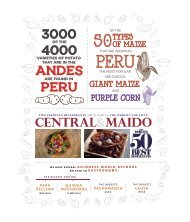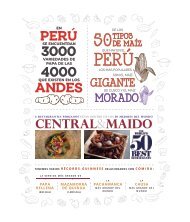UJ #17 - Traditional Peru
You also want an ePaper? Increase the reach of your titles
YUMPU automatically turns print PDFs into web optimized ePapers that Google loves.
Masks are decorated with<br />
metals and feathers, bringing<br />
together elegance and colour.<br />
Diego del Río<br />
troupes begin to arrive, presenting the Virgin with a joyous<br />
serenade that lasts throughout the night.<br />
The 16th is the day of the main celebration. At 5 am, devotees<br />
gather in the church for the Aurora mass, followed by the<br />
fiesta mass, which is given at 10 am. After the liturgy, the<br />
followers are invited to approach the Mamacha Carmen<br />
and hang their intention charms – requests written on<br />
metal plaques – on her dress, and/or light a candle: red for<br />
love, green for money, and purple for success.<br />
In the afternoon the Virgin, adorned in beautiful<br />
garments and set atop her plinth that resembles the sky,<br />
is taken out for a procession through the streets of the<br />
village. Suddenly, colourful Saqras – or devils – invade<br />
the rooftops that surround the plaza in attempts to<br />
hide from the Mamacha. Meanwhile, dance troupes<br />
fill the plaza preparing to perform their characteristic<br />
dance, each of which represents a different aspect of<br />
local history: the black slaves, the Spanish landowners,<br />
the Inca warriors, the Chilean invaders, and bullfighters,<br />
among others. The entire town and its visitors gather in<br />
the plaza and the surrounding balconies to witness the<br />
spectacle, tossing flower petals as the Virgin passes by,<br />
and paying special attention to the colour of her cheeks:<br />
pink cheeks signify good times, while pale cheeks suggest<br />
that the future will not be so auspicious.<br />
Diego del Río<br />
The 17th is the day of blessings. It begins in the local<br />
cemetery where deceased dancers are honoured with<br />
song and celebration, before moving on to bless the four<br />
suyos – or cardinal points – from the Carlos III Bridge, a<br />
colonial construction made of stone. In the evening, the<br />
people join their patron in the main plaza for the ‘battle’,<br />
during which the Qollas and the Antis come face to face.<br />
The 18th is dedicated to the children, who are taken to<br />
the church for the ocarikuy, and to be blessed by the<br />
Virgin and the local priest. Then, the final day brings with<br />
it the most emotional ritual of all. The Virgin is placed on<br />
her plinth and changed by the current fiesta hosts along<br />
with those chosen to organize the celebration in the year<br />
to come, in this symbolic ‘passing of the baton’ ritual. It<br />
is with this important gesture that the festivities come<br />
to an end, closing days of joy, devotion, and incredible<br />
cultural expressions that live on like treasures hidden in<br />
the small towns of <strong>Peru</strong>’s Andes Mountains.<br />
THE CELEBRATION OF THE VIRGEN<br />
DEL CARMEN WAS DECLARED<br />
INTANGIBLE NATIONAL CULTURAL<br />
HERITAGE IN 2006.<br />
Despite the<br />
weather,<br />
celebrations and<br />
dances in honour<br />
of the Virgin do<br />
not cease.<br />
49

















